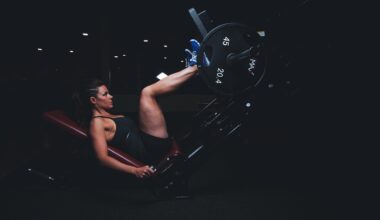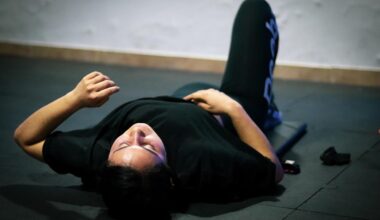The Future of Robotics in Senior Physical Fitness
As we look toward the future, robotics promises to revolutionize senior physical fitness practices remarkably. The integration of robotics into fitness routines offers numerous benefits for older adults, especially concerning mobility and safety. Robotic devices, such as exoskeletons and smart treadmills, can help seniors engage in exercises that may otherwise be too challenging or risky, thus promoting their overall health. Furthermore, companies are creating robots that assist seniors in tracking their progress and providing real-time feedback, enabling them to stay motivated. This technology fosters a sense of independence, allowing seniors to regain physical capabilities while reducing the risk of injury. Robotics also encourages social interaction by allowing seniors to connect through shared fitness experiences. Advances in artificial intelligence ensure that these gadgets adapt to individual needs, enhancing the personalized experience. These innovations represent a shift in how we view fitness; it is becoming increasingly accessible. A growing focus on fitness technology specifically designed for seniors indicates a promising future where older adults lead healthier lifestyles with the support of robots.
In addition to mobility helpers, gaming technology has emerged as a fun and engaging method to promote fitness among seniors. Interactive gaming systems use motions sensors and avatars that encourage physical activity while maintaining high levels of enjoyment. Engaging in fitness games challenges seniors physically and mentally, enhancing coordination and cognitive skills simultaneously. Through friendly competition, they can foster community and social bonds, combating loneliness among this demographic. Many communities have embraced group gaming sessions to promote motivation and accountability in fitness routines. Developers have partnered with fitness experts to design programs specifically targeting seniors, emphasizing low-impact activities that reduce strain. These programs promote cardiovascular health and strength training through enjoyable methods. Moreover, with the proliferation of virtual reality (VR) technology, seniors can immerse themselves in different environments while exercising, which helps distract from discomfort and makes workouts more appealing. Fitness technology is also paving the way for an interconnected world, where seniors can share their progress and experiences with families and friends, enhancing their overall support systems. As robotics ventures further into virtual reality, opportunities for socializing and reconnection are bound to expand.
Smart Wearables for Health Monitoring
Wearable technology plays a crucial role in the future of senior fitness, combining robotics with continuous health monitoring. Devices such as fitness trackers are designed to alert seniors to their activity levels, heart rates, and overall health metrics. The benefit of such wearables transcends mere tracking; they enable instant access to important health data. This information can be shared with caregivers or medical professionals, facilitating improved decision-making regarding health care. Wearables with AI capabilities can analyze patterns and recommend tailored fitness activities, ensuring seniors remain engaged based on their health status. For those with chronic conditions, wearables can monitor vital signs and alert the user when intervention is necessary. Furthermore, some devices are equipped with smart alarms urging users to remain active or reminding them to take necessary breaks. The data compiled by these devices suggests trends over time, allowing seniors to celebrate milestones in a spatiotemporally aware context. Such technology not only enhances health management but also empowers seniors with increased control over their fitness journeys, thus enabling them to embrace healthier lifestyles.
One of the significant challenges faced by seniors is the fear of falling during physical activities. However, robotics can provide a solution by incorporating safety features such as balance support systems. Advanced robotic devices can detect various movement patterns, alerting users when postures may lead to a fall. Additionally, robotic exercises are adaptable, meaning that if a senior feels fatigued, the device can modify the workout in real time. This flexibility prevents unnecessary strain and injuries, fostering confidence and encouraging continued participation. Furthermore, rehabilitation robots play a crucial role in strengthening stability and coordination. These devices assist patients recovering from surgeries by providing tailored exercises designed to improve their mobility gradually. With partnerships developing between fitness experts and engineers, future devices will reflect a deeper understanding of seniors’ physical limitations. Robotics not only ensures seniors engage in safe workouts but also helps build self-esteem as they overcome the hurdles of age-related decline. The continued evolution of safety-focused fitness technology will undoubtedly enhance the quality of life for seniors, making exercise enjoyable and hassle-free.
Community Engagement through Fitness Technology
Robotics in senior fitness is not just about individual experiences; it also plays a significant role in community-driven initiatives. Fitness technology fosters collaboration between seniors while encouraging collective goals. Many community fitness programs now incorporate dancing robots or automated exercise partners that promote interaction and bonding during sessions. This approach to fitness creates an inviting atmosphere, reducing resistance to attendance. By emphasizing fun and friendship, older adults become more motivated to participate in physical activities that they may have previously shunned due to embarrassment or insecurity. Virtual platforms have emerged, allowing seniors to attend classes remotely and engage in group settings. These channels bridge geographical gaps, helping seniors maintain social connections and share their experiences. Moreover, robotics motivates intergenerational interactions as younger family members or volunteers may join seniors in their fitness pursuits. Such engagements reveal mutual benefits, enhancing everyone’s sense of purpose and achievement. As technology continues to grow, maintaining these community-oriented initiatives alongside robotics will be vital to sustaining the health and happiness of our senior population.
Incorporating robotics and artificial intelligence into senior fitness is fueling an evolution in data-informed techniques for wellness. Sensors and algorithms contribute to evaluating individual performance, providing insights that many older adults appreciate. For instance, robotic tools may indicate when seniors need to increase their exercise intensity or shift activities to avoid overexertion. This level of personalization encourages seniors to set realistic goals based on their unique capabilities. Health outcomes can vastly improve through consistent feedback and insights, moving away from standard, one-size-fits-all plans. Moreover, community trainers increasingly utilize data analytics to personalize fitness programs to cater precisely to seniors’ needs. With more insight into health markers, trainers can optimize their strategies, ensuring members achieve necessary fitness benchmarks. Technological advancements will yield even smarter devices capable of predicting health issues before they escalate through continual evaluation. These insights will extend beyond physical capabilities, shaping nutritional and lifestyle changes. As these innovations persist, seniors can navigate the future of fitness confidently, embracing opportunities for healthier lives and newfound enjoyment in their physical well-being.
Conclusion: Embracing the Future
The future of robotics in senior physical fitness is undoubtedly bright. The integration of robotics within the fitness industry presents transformative opportunities that cater specifically to seniors’ unique needs. From enhanced mobility solutions to engaging interactive gaming technologies, seniors can expect a fitness landscape that feels accessible and enjoyable. As awareness of the importance of fitness for aging populations grows, innovation will continue to address the barriers they face. Furthermore, community-based initiatives will promote social interactions, enriching the experiences of older adults significantly. The emergence of smart wearables and AI-driven insights will enable seniors to manage their health with a level of awareness previously unattainable. By fostering confidence and empowerment, robotics will redefine how older adults perceive fitness, encouraging lasting habits that lead to improved health outcomes. In embracing these technological advancements, seniors can look forward to an active future filled with possibilities for enhancing their overall well-being and enjoying their golden years like never before.
The constant evolution of robotics in fitness technology stands as a testament to how we value our aging populations. With a comprehensive approach to addressing health needs, the future holds promise where seniors will lead physically active lives supported by innovative advancements. Effective frameworks exist for ensuring that technology is both safe and catered to those needing additional assistance. As we forge ahead, it is essential to remain vigilant about inclusivity, ensuring that all elderly individuals access and benefit from these advancements in fitness technology. Collaboration among engineers, healthcare professionals, and fitness experts will ensure that tailored solution creation remains the primary focus. This will solidify a robust ecosystem of fitness that fosters positive change in health and well-being for seniors. Thus, as our society continues to adapt and transform, fostering relationships between robotics and physical fitness will open doors to healthier, longer lives for older adults to thrive.


